[This is post #8 of 21 posts about our 2024 trip to Africa. To go to the first post in the series CLICK HERE. At the end of the last post there is also a Directory with links of all 21 posts.]
It was now September 14, Day 5 of our Africa trip. Our time thus far on safari had all been spent in far north Serengeti National Park along or near the Mara River. Today we were going to head up river to explore a different part of the river, then begin the trip south as seen on the blue track on the map below. Our destination for the night would be our next camp, Mbuzi Mawe Serena Camp (the green square near the bottom of the map), which is at the far northern edge of Central Serengeti.
As we were walking back to the room from breakfast, we could see and hear huge numbers of wildebeest in the area behind our room. By the time we got to our back patio they had mostly dispersed, but it was still obvious there were many of them and they all seemed to be on the move.
 |
| Lots of wildebeest in the distance as seen from our back patio, unfortunately taken with my iPhone. |
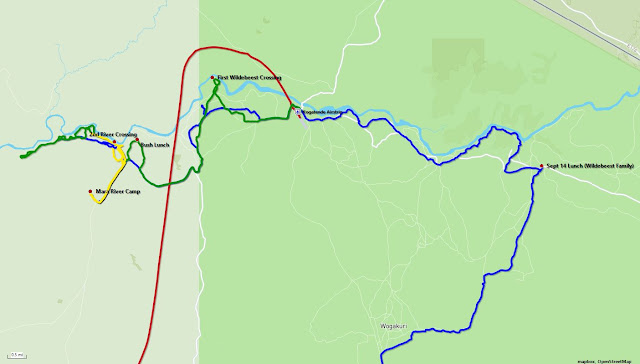 |
| GPS tracks for Days 4-5 along Mara River. |
We had barely left camp when we encountered the wildebeest, this time with elands.
 |
| Wildebeest and Common Eland. The eland in the center has two birds, oxpeckers, eating the insects on his back. |
Once we got to the river, there was a large group of wildebeest that looked like they were going to cross.
Unfortunately it was yet another false alarm.
Other critters. Waiting for the wildebeest did give us the opportunity to see some other animals that we had not seen before.
 |
| Baboon |
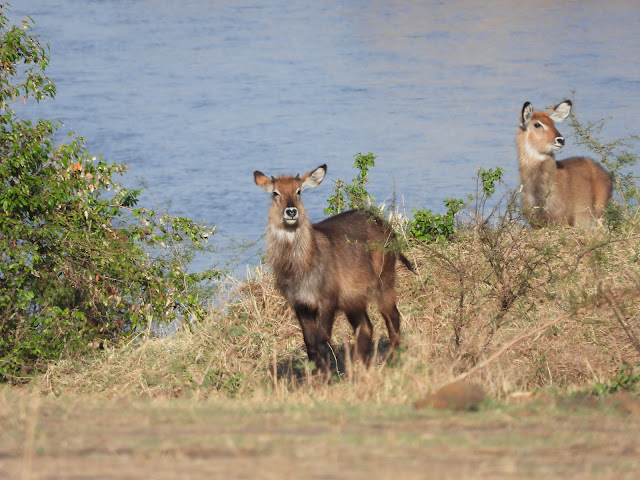 |
| Waterbuck, yet another type of antelope. I am guessing female in the background (no horns) and juvenile male in the foreground (tiny horns). |
 |
| Male Waterbuck. Only the males have horns. |
Of course there were also some birds. We are still in awe at how many brilliantly colored birds we saw.
 |
| Superb Starling |
 |
| Juvenile black-headed heron (I think) |
Since a river crossing did not look promising, we decided to move on. Having seen how indecisive the wildebeest can be even with huge numbers of them assembled, we felt very fortunate to have seen two river crossings.
Even moving away from the river, there seemed to be wildebeest everywhere. When on the move they seemed to travel in long, single file lines.
 |
| Wildebeest on the move. |
 |
| Wildebeest trudging along |
Mob of Mongooses. With so many wildebeest on the move in the area, it is not unexpected that some did not make it. We came across this group or mob of Banded Mongooses on a Wildebeest carcass. Yes, "mongooses" really is the plural, not mongeese.
 |
| Large group of Banded Mongooses on a wildebeest carcass |
I am not actually sure what they were eating, the wildebeest meat or insects on the carcass. I assumed when we saw them that they were eating the carcass, but Wikipedia indicates they primarily feed on insects and small animals. They don't mention anything about scavenging.
Whatever it was, it is obvious from the video below they were aggressively going after it.
My only previous "knowledge" of anything related to mongooses was the story of Rikki Tikki Tavi (thank you Rudyard Kipling). According to Wiki, mongooses really do have a mutation that protects them from snake venom. Fortunately I did not have to witness anything along those lines first hand.
Zebra. Zebra are also part of the migration along with the wildebeest, so it was not surprising that we kept encountering plenty of zebra. I am not sure what they were thinking, but they often stopped to watch us.
 |
| A Zebra seemingly curious about us |
Not deserted. Looking more closely, with the help of Fazal, we quickly discovered that that the river was not deserted after all. Once we knew to look for them, we started to see crocodiles everywhere.
Some were on the rocks, although partially camouflaged.
 |
| Enjoying the sun on a warm rock |
Some were partly submerged or at least wallowing in the mud.
 |
| These two chose the water and mud |
While others cooled off by opening their mouths.
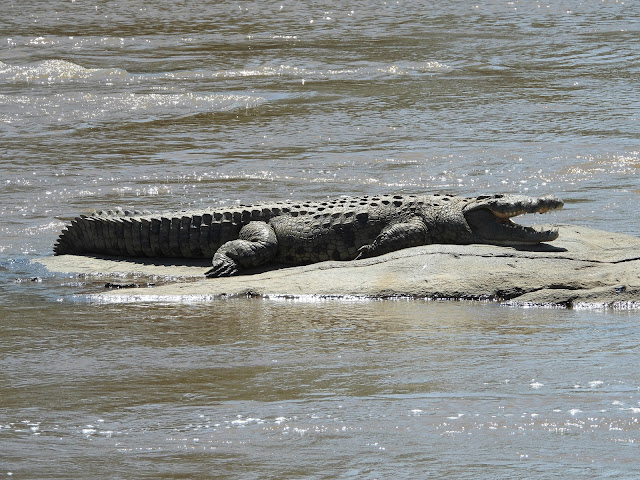 |
| Asleep with his mouth open |
Hippos. Continuing further east we came to several pools of deeper water with lots and lots of hippopotamuses.
Most were submerged in the water, which is normal daytime behavior.
We saw several groups as we proceeded up the river.
Looking closely we could see the birds known as oxpeckers at work eating insects.
Somewhat surprisingly, given that it was nearing midday, not all of the hippos were in the water.
They certainly have a pig-like appearance, but their closest living relatives are cetaceans (whales, dolphins, porpoises, etc.), from which they diverged about 55 million years ago. Maybe this fits with what we learned in Glacier Bay NP two years ago, that whales used to be land animals in the distant past.
We were even lucky enough to spot some calves. Although they look small, I am not sure how little they really are. Newborns average 110 pounds at birth, but the mother does not return them to the herd until they are several weeks old. These are obviously beyond that stage. Size is probably all relative. Adult females average 2,900 pounds, while males are typically 3,300 pounds.
 |
| A couple of baby hippos |
 |
| Best buds |
Birds. We saw numerous birds along he river. I had already mentioned the oxpeckers on the hippos.
 |
| Yellow-billed Oxpeckers |
Many of the birds were quite beautiful.
 |
| Spur-winged Lapwing |
Others were interesting, but kind of dorky looking.
 |
| Yellow-billed stork. These are big guys. According to Wiki they stand 36-41 inches tall. |
 |
| A covey of Helmeted guineafowl |
Drama on the river. Some were even on the slightly ugly side, but this little bird ended up in the middle of a drama that played out in front of us.
 |
| Water thick-knee |
The Water thick-knee makes its nest close to the water. It isn't usually much of a nest, possibly only a scrape in the sand. However it has an interesting relationship with the crocodiles.
"Unique among birds, thick-knee pairs frequently nest adjacent to and sometimes directly on top of Nile crocodile nests. The two species share a form of symbiotic mutualism with the more energetic and vocal thick-knee functioning as loud sentries for the nests as the more powerful crocodile provides protection. Should a nest raider approach, the thick-knee pair will spread their wings in a threat display and harass and peck at the intruders to drive it off. If the pair not be successful, the mother crocodile will be drawn in by their continued calls and arrive." [https://en.wikipedia.org/wiki/Water_thick-knee]
No crocodile to the rescue this day. It did not quite work out that way this day. We spotted this monitor lizard working its way among the rocks. We also heard the bird putting up quite a fuss.
 |
| Monitor lizard. Note the tongue. |
Unfortunately, as you can see in the video below, no crocodile came to the rescue today. The lizard got his lunch.
Nearby land animals. Interspersed among these sightings on the river were numerous land animals.
Juvenile wildebeest. Of course we saw wildebeest, they are everywhere, but we were surprised to see the one below with straight horns. It is apparently a juvenile. The horns grow in straight and do not begin to curve until they are about 8 months old.
 |
| Juvenile wildebeest in the rear with straight horns, adult in the front. |
Warthog. In a mud puddle somewhat off the side of the road we saw our first warthog. Since this guy was alone and seemed large, he was likely a male. Warthogs are actually rather ferocious animals with their sharp tusks. I knew they had tusks. but did not realize before that there are two sets. According to Wiki, the lower pair, which is far shorter than the upper pair, becomes razor-sharp by rubbing against the upper pair every time the mouth is opened and closed. All the more reason to stay clear of these guys. Fortunately for us this fellow pretty much ignored us.
 |
| Yes, a Common Warthog. He did not seem nearly as lovable as Pumbaa in The Lion King. |
African buffalo. We even saw some buffalo on the far bank of the river. Buffalo are often considered the most dangerous of the Big Five because they are very aggressive. Unlike lions or elephants, they don't bluff charge. If they are annoyed with you they come full steam ahead and don't stop. More than 49% of buffalo attacks on humans result in the human dying, which is higher than leopard or lion attacks. They are particularly feared by big game hunters since wounded animals have been reported to ambush and attack
pursuers. It is probably just as well they were on the other side of the river.
 |
| Hippos in the river and African buffalo on the far bank |
Film Crew following Leopards. Fazal was constantly on the radio to other guides. At one point he said we needed to make a slight detour. One of his very good friends was nearby driving for a professional film crew.
 |
| Film crew with an enormous camera on the front |
Of course we were very impressed by the enormous camera mounted on the front of the vehicle.
Apparently they were following leopards. We assumed that meant they were filming at least part of the time at night since leopards are primarily nocturnal.
I don't know who they were filming for. There was some mention of National Geographic. I later heard mention of Netflix. I hope so. I will definitely be on the lookout.
The river bends north and we go south. We had already seen a lot in the relatively short distance along the stretch of the Mara River east of Kogatende airstrip. Following the river would have taken us more to the northeast, but we needed to get started on our long drive south.
As the river bent more to the north we went south and started to look for a place to enjoy our box lunches.
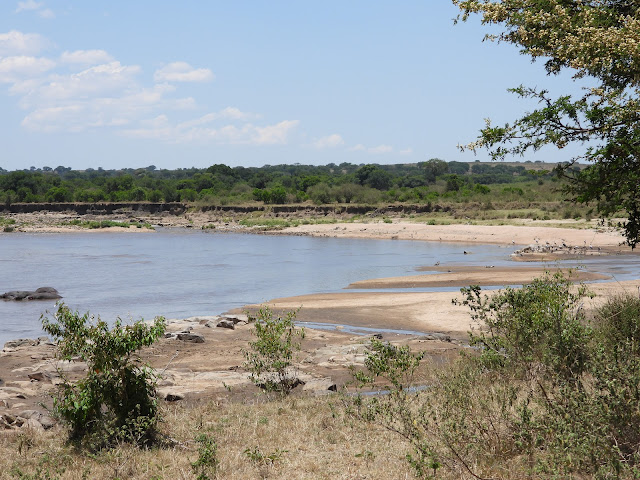 |
| The river bends north as we go south |
Before we could get settled into a shady place for lunch we encountered some new and interesting things, including a baby warthog! All of that and more is the subject of the next post.
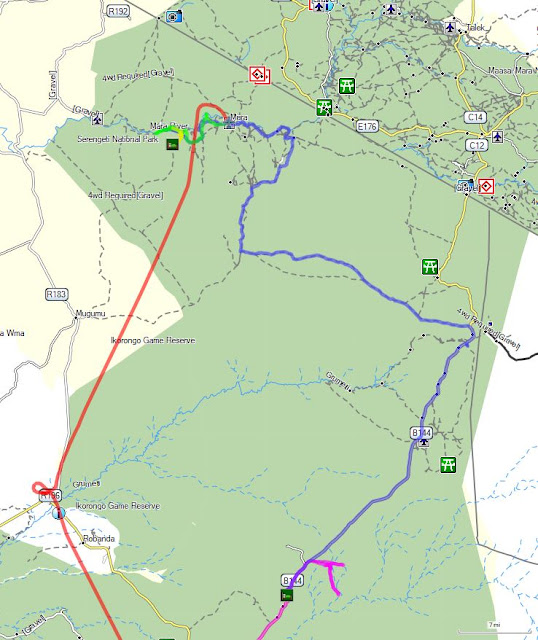







No comments:
Post a Comment